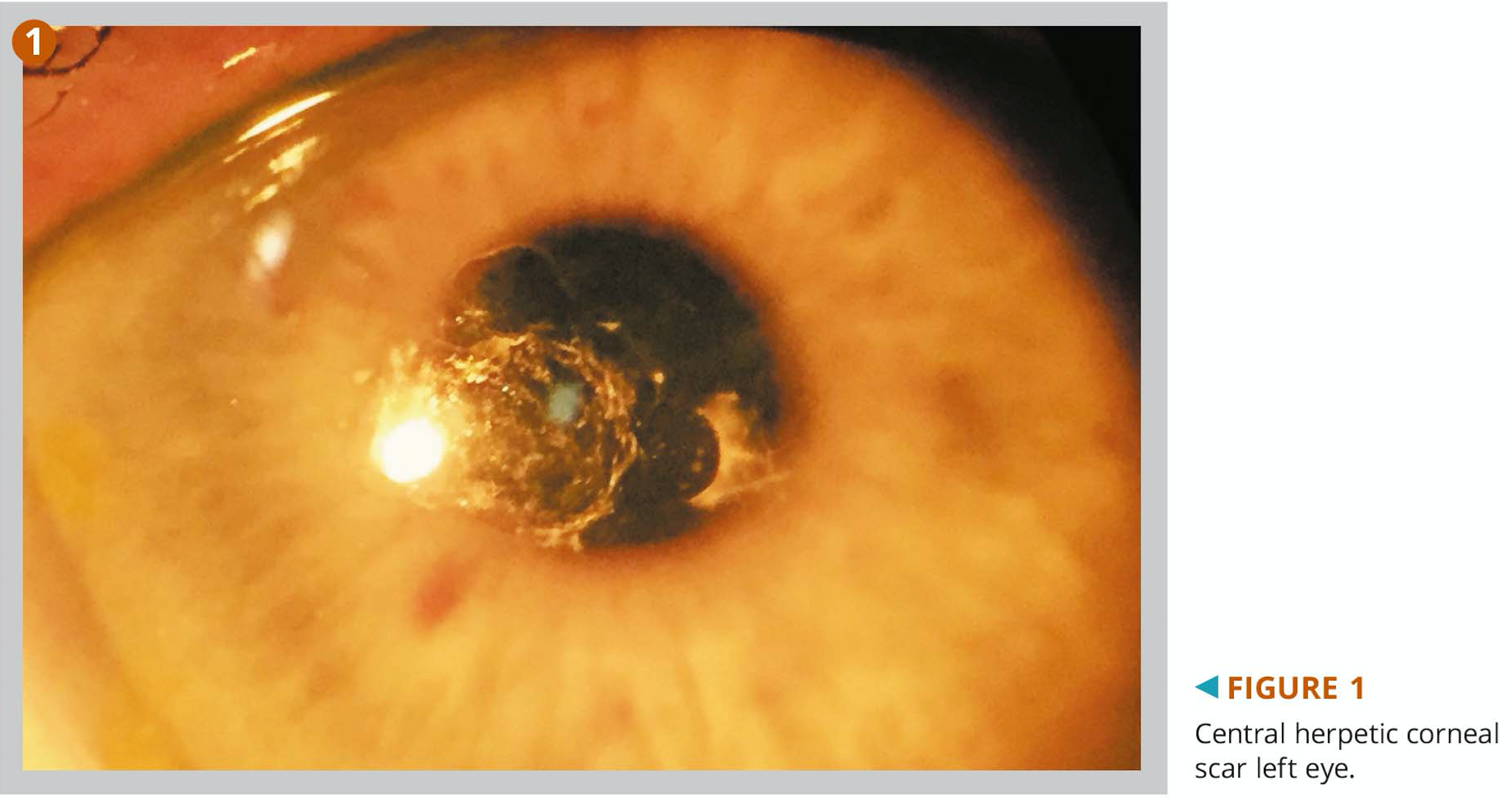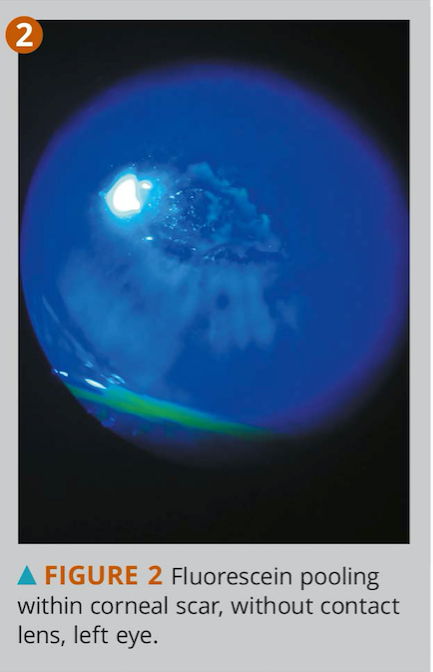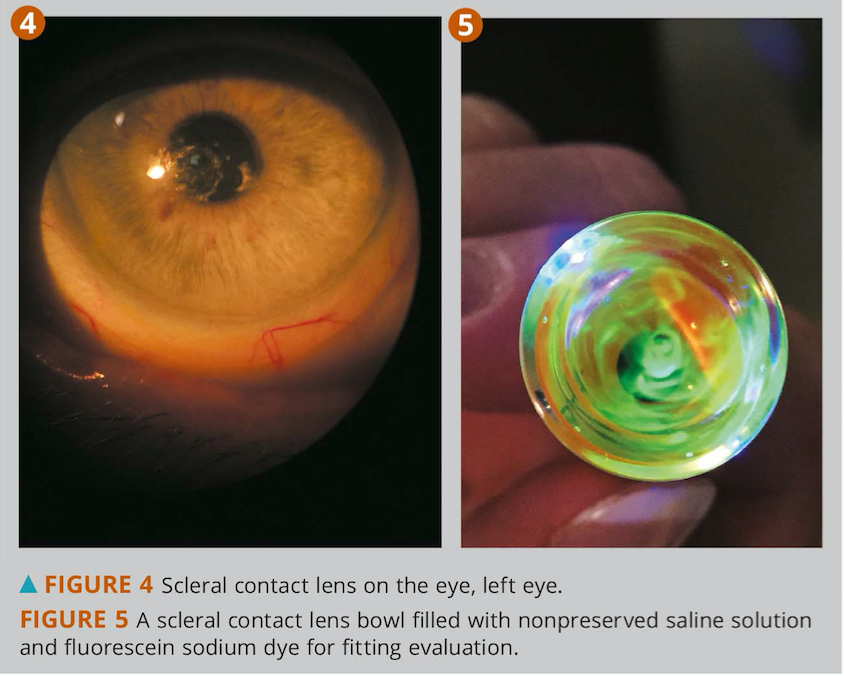Scleral lens aids in visual rehabilitation




Scleral contact lenses are one of the fastest growing markets in the contact lens industry today and can be used to fit a wide range of ocular conditions.
By design, scleral lenses completely vault an irregular cornea, providing the optics of a rigid gas permeable lens, but with the comfort of a soft lens.
Scleral lenses also provide a liquid reservoir to bathe the cornea, giving protection and lubrication to the corneal surface.
Scleral lenses are an excellent choice for patients with corneal pathology in one eye for which special correction is needed. Such is the interesting case study of a patient with a herpetic corneal scar who presented to the contact lens clinic for visual rehabilitation.
Case study
An 81-year-old woman presented for a contact lens evaluation in her left eye. She had a history of a longstanding quiescent central corneal scar on her left eye due to herpes simplex keratitis.
For many years, she tolerated her vision successfully with best-corrected visual acuity (BCVA) of 20/25 OD and 20/200 OS until she developed an amelanotic chorioretinal tumor on her right eye. Her visual acuity dropped to 20/60 in her right eye, and she complained of difficulty seeing.
Related: Considering scleral lenses for astigmatic patients
On initial evaluation, her spectacle correction vision was 20/60 OD and 20/200 OS.
External exam showed small palpebral fissures with a horizontal visible iris diameter (HVID) of 11.2 mm OS.
Slit-lamp evaluation revealed OD: 2+ combined cataract with a clear cornea; OS posterior chamber intraocular lens with a 4.5 x 3.5 central corneal scar with 40 percent thinning (see Figure 1). There was fluorescein pooling within the scar but no staining (see Figure 2).
Topography showed marked elevation differences (~20.00 D) from the area of the depressed corneal scarring to the superior cornea of the left eye.
Fundus examination revealed OD a large choroidal nevus with a small area of subretinal fluid that extended into the macula with a possible neovascular membrane; OS was unremarkable.
Her medications included Lotemax (loteprednol, Bausch + Lomb ) left eye daily, artificial tears three times daily in both eyes, and Famvir (famciclovir, Novartis) 500 mg by mouth once per day.
Given the large asymmetrical astigmatism in the left eye and the need for a single contact lens, she was recommended for a scleral rigid contact lens OS.
The patient was fit into a small diameter mini-scleral contact lens:
OS: Base curve 7.40 mm; Diameter 14.3 mm; Power -3.00 D; Standard edge profile; Material Tyro 97 (hofocon A, Lagado Corporation).
During the initial evaluation, corrected vision was 20/50+ OS. Slit-lamp evaluation revealed a well-fitted lens with approximately 200 to 250 µm of central clearance (see Figure 3). There was good limbal clearance and conjunctival-scleral edge alignment,and no compression or blanching of conjunctival vessels.
Related: 10 tips to enhance scleral contact lens success
The patient reported good lens comfort and vision. She was instructed on application and removal of the contact lens; however, she had difficulty applying the lens. The biggest concern was a bubble formation under the lens after application. After multiple attempts, her husband assisted with application and removal of the lens.
The patient and her husband were both instructed on the care and cleaning of the contact lens, and she was given a conservative wearing schedule until her first follow-up visit.
Patient follow-up
The patient was monitored closely for complications.
On her first follow-up visit, visual acuity had improved to 20/40 OS. Slit-lamp examination of the left eye showed a well-fitted lens with a clearance of 150 µm. There was good edge haptic alignment with no blanching or compression of the conjunctival vessels (see Figure 4). Her cornea was clear and quiet with no changes to the herpetic scar.
The patient reported good comfort and vision with the lens, wearing it approximately six hours a day. She eventually increased her wearing schedule up to 10 to 12 hours a day.
The patient was followed closely by her referring ophthalmologist without changes or inflammation to the herpetic scar on the left eye. She has done well with the management of her scleral lens and has successfully worn the lens for the past three years.
Due to the vaulted lens design, the parameters and fit have remained unchanged, though the patient has gone through several lenses due to breakage and loss.
However, since her initial contact lens evaluation, the right eye has continued to progress. The patient underwent cataract surgery along with three transpupillary thermotherapy (TTT) treatments, plaque brachytherapy, and two Avastin (bevacizumab, Genentech) injections in the right eye to slow the progression of the amelanotic chorioretinal tumor.
At her last examination, BCVA was counting fingers 2 feet OD and 20/40+ OS with scleral contact lens. Wearing the lens has allowed the patient to maintain quality of life and functional vision, although recently she expressed difficulty reading and has stopped driving.
She has followed up with a low-vision specialist for additional consultation and resources.
Discussion
Scleral contact lenses were first described in the late 1880s.1 The technique involved taking a mold of the eye, then glass blowing a scleral contact lens shell that was fit to the eye. The glass was impenetrable by oxygen, so small fenestrations or holes were drilled into the glass to allow oxygenated tears to flow beneath the lens. Hypoxia and reproducibility of the early scleral lenses were major challenges.
Modern scleral contact lenses re-entered the market in the early 2000s.2 With advancements in computer-generated lathing technology, increased reproducibility, and hyper-Dk materials, scleral lenses are another tool for contact lens practitioners. Their many uses include irregular corneas and ocular surface disease, as well as normal corneas, especially those with dry eye or previous contact lens intolerance.
Related: 3 tips to better fit keratocones with scleral lenses
Scleral contact lenses are available in hyper-Dk fluorosilicone acrylate (FSA) materials with Dks of 97 to 150 to maintain corneal oxygenation. The large diameter, ranging from approximately 12 to 24 mm, allows for the lens to vault completely over the corneal surface, providing a fluid-filled tear reservoir. Depending on lens design, the lens vaults or carefully approximates the limbal area, where it lands several millimeters beyond the limbus onto the conjunctival-scleral tissue.
Lenses are best fit using manufacturer guidelines for the specific lens design, and most manufacturers have both prolate and oblate lens designs for irregular, regular, and surgically altered corneas. Fitting options can include toric peripheral curves, anterior toric optics, quadrant specific designs, multifocals, and new Tangible Hydra-PEG (Tangible Science) coating to improve wettability.
Conclusion
A scleral contact lens is an excellent option for visual and therapeutic rehabilitation. It provides superb visual acuity with all-day comfort while the fluid-filled reservoir provides moisture and corneal surface protection. It can be a successful visual rehabilitation tool for patients with corneal irregularities.
With a well-fitted lens, proper care, and good follow-up, patients can comfortably and successfully return to their daily activities.
References:
1. Barnett M, Johns L. Perspectives on scleral lenses: past, present and future. CL Update. Available at: https://contactlensupdate.com/2017/07/26/perspectives-on-scleral-lenses-past-present-and-future/. Accessed 11/25/2018.
2. Jedlicka J. Scleral Lenses: Past and Present. CL Spectrum. Available at: https://www.clspectrum.com/supplements/2016/october-2016/scleral-lenses-understanding-applications-and-max/scleral-lenses-past-and-present. Accessed 11/24/18.
Newsletter
Want more insights like this? Subscribe to Optometry Times and get clinical pearls and practice tips delivered straight to your inbox.